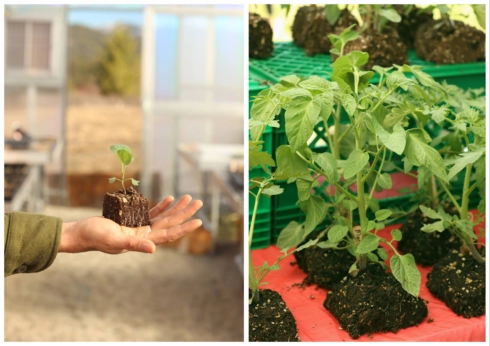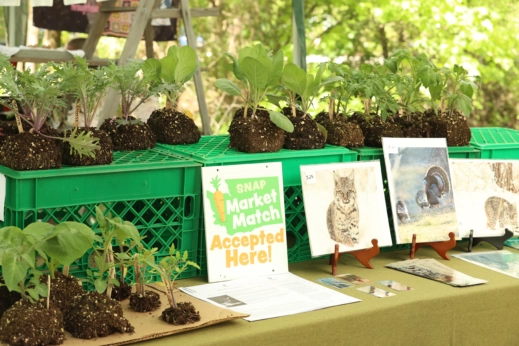Soil blocking is a plastic-free seed-starting method that’s gaining popularity as farmers and gardeners look to more sustainable practices.

I’ve been a regenerative farmer for nearly two decades, currently operating Blue Ridge Farm in a remote corner of northeastern Washington State. One of my four key farm values is a commitment to decreasing waste, especially in the form of plastic. This is a big reason why the concept of soil blocking first captured my attention: It would allow me the ability to stop relying on plastic plant pots.
I raise and sell several hundred vegetable, flower and herb starts every spring, which meant that I was constantly purchasing plastic pots. In my experience, even high-quality plastic pots tended to fall apart after a few years, and I knew many people who simply threw them away after a single season of use. The idea of eliminating this form of waste was appealing to me, as was the additional promise of raising healthier plants in the process.
What is soil blocking?
Soil blocking is the practice of utilizing compacted blocks of soil to germinate and grow out seedlings before transplanting them into the garden. Soil blocks act as both the container and the growing medium, relying on a metal tool called a soil blocker to create the compressed cubes.
Although the concept of soil blocking has been around for quite some time, its popularity has been steadily gaining traction, touted by many regenerative-minded farmers and adventurous home gardeners as a way to decrease plastic waste and the resulting impacts to the environment. “Soil blocks are the answer for a farm-produced seedling system that costs no more than the soil of which it is composed,” writes Eliot Coleman, a vanguard of the modern soil-blocking movement, in his seminal book, The New Organic Grower. “Blocks free the grower from the mountains of plastic [trash] that have become so ubiquitous of late in horticultural operations.”
Soil blocking is also gaining in popularity because it promotes a healthier root system by utilizing a process known as “air pruning.” Due to the freestanding nature of each soil block, the plant roots are exposed to oxygen on all sides. The result is that, as the plant roots hit the outside edge of the soil block, they are effectively “burned” off via exposure to air, causing the plant to consistently produce new branching roots and thereby creating an overall healthy root system.
When it comes time to move seedlings into the garden, soil blocking also allows for a gentler method of planting, thereby reducing transplant shock. Even plants that normally don’t like having their roots disturbed, such as cabbage, can be grown and transplanted successfully using soil blocks.

Left: A young soil blocked collard seedling in the Blue Ridge Farm greenhouse. Right: Soil blocked plant at the farmers market. (Photos: Jillian Garrett)
Daniel Mays, founder of Frith Farm and another early adopter of the practice, believes that soil blocking also allows for the creation of a larger rhizosphere, (which is defined as the zone of soil where complex symbiotic interactions take place between the plant’s roots and beneficial microbes and fungi), because each block holds more soil than the tapered cells of plastic plug trays. “This means more roots, more soil contact and a more resilient plant.”
The opposite holds true for a plant raised in a traditional plastic pot: The plant’s roots become restricted and, having nowhere to go, head downward to the bottom of the pot, eventually resulting in what feels like an infinite swirl of frustration. When this happens, it is called becoming “rootbound” and this condition can not only stunt the plant but (in extreme cases) potentially even kill it. After being put in the ground, a rootbound plant can remain stunted, unable to overcome its constricted root system. It may take much longer to establish and, in the case of garden vegetables, produce a lower overall yield.
Now that we’ve covered many of the reasons in favor of soil blocking, what about the drawbacks? To be fair, soil blocking does involve a bit of an upfront commitment in the form of the costs associated to purchase the necessary tools, as well as a bit of extra labor involved to make the soil blocks themselves. I believe that these small obstacles are still vastly outweighed by the benefits that the overall system provides (not least of which, for my farm, included increased sales by offering a unique product).
How to soil block
So, you’ve decided to try your hand at soil blocking—now what? The first thing you need to get started is one or more sizes of soil blockers, which are essentially an ejection-style press that compacts the soil into squares. You can choose from either smaller handheld versions (good for home gardeners and more economical in pricing) or larger (and more expensive) stand-up style ones. Most blockers come in several sizes, allowing you to keep sizing up your soil blocks as the seedlings grow and require more space.
On my farm, I use three different sizes of handheld soil blockers. To germinate small seeds, I usually begin with a 20-square press (3/4-inch-diameter block size). When dealing with larger seeds such as okra, it’s best to skip this press size and germinate them directly into two-inch-diameter blocks. The one issue to keep in mind with the smaller block size is that the soil can dry out faster than with the larger blocks, so care and attention is needed so as not to accidentally lose fragile seedlings.
At the onset of the seedlings’ first true leaves, I move them into two-inch-diameter blocks made using the four-square press. As the seedlings become more mature, I move them up to the final four-inch-diameter block size, using the one-square press, a couple of weeks prior to transplanting them into the garden.
Part of what holds the soil block together is the established root system of the plant. It generally takes a couple of weeks for each seedling’s roots to fill out the soil block, so I highly recommend waiting for that amount of time before moving a seedling up in block size. I also recommend waiting until the seedlings have established roots in their soil blocks before attempting to transport them to market.

Soil blocked plant starts make a unique and popular display at the farmers market. (Photo: Jillian Garrett)
There are as many different formulas for ideal soil-blocking mixtures as there are farmers using the method. Each person has their own idea of what works, and everyone thinks that their recipe is the best. At the end of the day, the important part is that your soil mix is compactable but still possesses good drainage, which is why many folks recommend a blend that includes finely sifted compost (or potting soil) and coconut coir. I recommend experimenting to see what works for you and coming up with your own special blend. It can be something as simple as off-the-shelf seed starter soil or as bespoke as a mix of fine-grained homemade compost and sand with a small amendment of pulverized egg shells (such as that used by Siskiyou Farm).
I also recommend using a deep rectangular tray (or even a wheelbarrow) in which to mix your soil medium. The secret to soil blocking is achieving the right consistency: If it’s too dry, it’s prone to crumble and fall apart; if it’s too wet, the blocks will slump over and deform. To make the mixture stick together and compact well in the blocker, you need to add a lot more water than you would think. According to Coleman, the ideal consistency is “much moister than most growers are used to. We are talking about something akin to chocolate fudge mix.” Essentially, it needs to be moist enough that, when you squeeze a handful of the soil mixture, a little water comes out.
After you have filled all the squares in the blocker with soil mixture and smoothed off any excess, press firmly until you see water seeping out of the bottom. Then, release the handle and gently lift the blocker away (I recommend also using a slight rocking motion as you lift up), thereby freeing the soil block squares. Don’t feel bad if your first few attempts end in tragedy (mine certainly did!); perfecting this technique can take a little practice.
Beyond decreasing my reliance on plastic, soil blocking has had the added benefit of increasing my plant sales. By being one of the first farms to implement it on a commercial scale in my area, I can offer a unique product that really piques customers’ interest. Displaying shelf after shelf of soil-blocked plants in my farmers market booth is an excellent recipe for attracting curious passersby who want to know more about the pot-less plants. I have noticed a marked uptick in foot traffic and revenue at my booth by offering my plants in soil-blocked as opposed to potted form.
While soil blocking does require a bit more labor and an upfront investment in tools, its benefits far outweigh these minor obstacles. Eliminating the need for plastic pots, creating healthier plants and root systems and—if you’re selling plant starts— increasing sales, are all reasons to give soil blocking a try.
Hi! I love the idea of using soil blocks, but I am curious about a few things I didn’t see mentioned in the article;
How do you water the seedlings without dissolving the soil blocks?
How do you transfer the seedlings into larger soil blocks?
How do your customers carry the seedlings they purchase home with them if not by putting them into a plastic bag?
Thanks!
So many hours making blocks of soil. And then upsizing to larger blocks. And again. Surely the heavy-duty re-usable pop-up plastic trays or even compostable or paper pots make more sense at scale! Or many, like our forefathers, you have 10 or 12 children helping out?
I realize that many of the habits we choose in order to be environmentally conscious are inconvenient ,and some come at an added cost, but if you’re supporting yourself as a market farmer this seems like a quick path to needing a new means of support.
So how do you package the soil blocks for your farmers’ market customers to take home?
How do your customers carry the seedlings they purchase home with them if not by putting them into a plastic bag?
Smaller block sizes can cause the soil to dry out more quickly, requiring careful attention to avoid losing delicate seedlings.